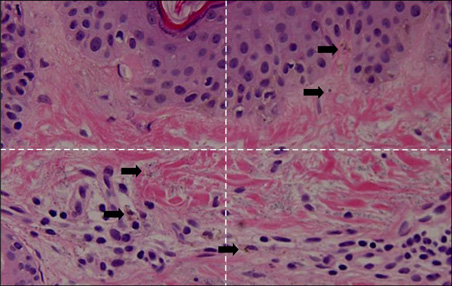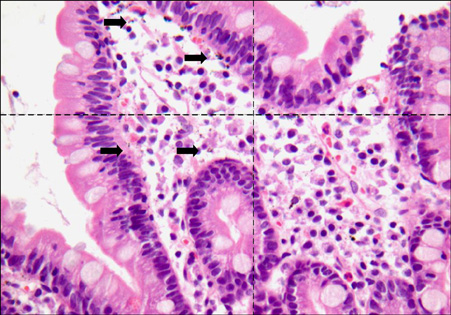Ann Dermatol.
2009 Aug;21(3):308-310. 10.5021/ad.2009.21.3.308.
A Case of Argyria Following Colloidal Silver Ingestion
- Affiliations
-
- 1Department of Dermatology, Dongguk University International Hospital, College of Medicine, Dongguk University, Goyang, Korea. lay5604@naver.com
- 2Department of Pathology, Dongguk University International Hospital, College of Medicine, Dongguk University, Goyang, Korea.
- 3Department of Occupational Medicine, Dongguk University International Hospital, College of Medicine, Dongguk University, Goyang, Korea.
- KMID: 2266299
- DOI: http://doi.org/10.5021/ad.2009.21.3.308
Abstract
- Argyria is a rare cutaneous discoloration caused by the intake of silver or various compounds containing silver. We report a case of argyria in a 73-year-old male following ingestion of colloidal silver as an alternative medicine over 5 years. He had a diffuse, slate gray discoloration of his face and hands. A biopsy specimen from the face revealed brown-black extracellular granules in the upper dermis and between collagen bundles. We also found silver particles in the mucous of the colon. The ingestion of colloidal silver appears to be increasing among patients using alternative health practices. We report this case to bring people's attention to the problems associated with the ingestion of colloidal silver.
Keyword
MeSH Terms
Figure
Reference
-
1. Fung MC, Bowen DL. Silver products for medical indications: risk-benefit assessment. J Toxicol Clin Toxicol. 1996. 34:119–126.
Article2. Payne CM, Bladin C, Colchester AC, Bland J, Lapworth R, Lane D. Argyria from excessive use of topical silver sulphadiazine. Lancet. 1992. 340:126.
Article3. White JM, Powell AM, Brady K, Russell-Jones R. Severe generalized argyria secondary to ingestion of colloidal silver protein. Clin Exp Dermatol. 2003. 28:254–256.
Article4. Park JW, Jung KE, Jin WW, Jung JG, Ro KW, Kim MH, et al. A case of generalized argyria caused by ingestion of silver solution. Korean J Dermatol. 2007. 45:1087–1089.5. Shelley WB, Shelley ED, Burmeister V. Argyria: the intradermal "photograph," a manifestation of passive photo-sensitivity. J Am Acad Dermatol. 1987. 16:211–217.
Article6. Hill WR, Montgomery H. Argyria: with special reference to the cutaneous histopathology. Arch Derm Syphilol. 1941. 44:588–599.7. Tanner LS, Gross DJ. Generalized argyria. Cutis. 1990. 45:237–239.8. Rosenman KD, Moss A, Kon S. Argyria: clinical implications of exposure to silver nitrate and silver oxide. J Occup Med. 1979. 21:430–435.9. Hill WR, Pillsbury DM. Argyria; the pharmacology of silver. 1939. Baltimore: The Williams & Wilkins Company;128–132.10. Wadhera A, Fung M. Systemic argyria associated with ingestion of colloidal silver. Dermatol Online J. 2005. 11:12.
Article11. Prescott RJ, Wells S. Systemic argyria. J Clin Pathol. 1994. 47:556–557.
Article12. Peterson WC Jr. Argyria. Minn Med. 1968. 51:533–534.13. Granstein RD, Sober AJ. Drug- and heavy metal--induced hyperpigmentation. J Am Acad Dermatol. 1981. 5:1–18.
Article14. Boyd AS, Seger D, Vannucci S, Langley M, Abraham JL, King LE Jr. Mercury exposure and cutaneous disease. J Am Acad Dermatol. 2000. 43:81–90.
Article15. Maloney ME. Arsenic in dermatology. Dermatol Surg. 1996. 22:301–304.
Article16. Smith RW, Leppard B, Barnett NL, Millward-Sadler GH, McCrae F, Cawley MI. Chrysiasis revisited: a clinical and pathological study. Br J Dermatol. 1995. 133:671–678.
Article17. Wolf ME, Richer S, Berk MA, Mosnaim AD. Cutaneous and ocular changes associated with the use of chlorpromazine. Int J Clin Pharmacol Ther Toxicol. 1993. 31:365–367.18. Trimble JW, Mendelson DS, Fetter BF, Ingram P, Gallagher JJ, Shelburne JD. Cutaneous pigmentation secondary to amiodarone therapy. Arch Dermatol. 1983. 119:914–918.
Article




